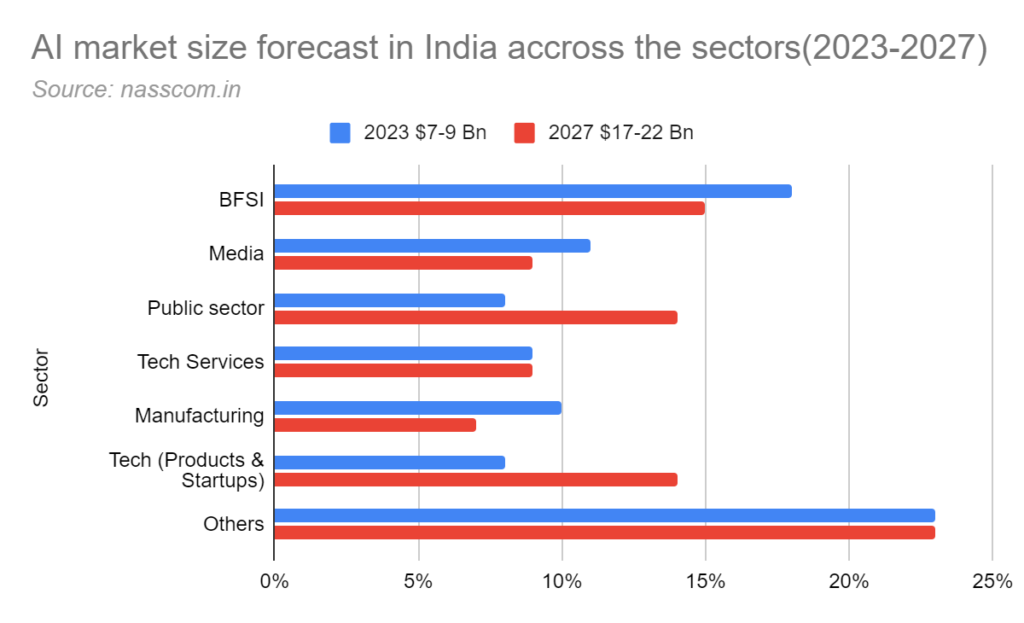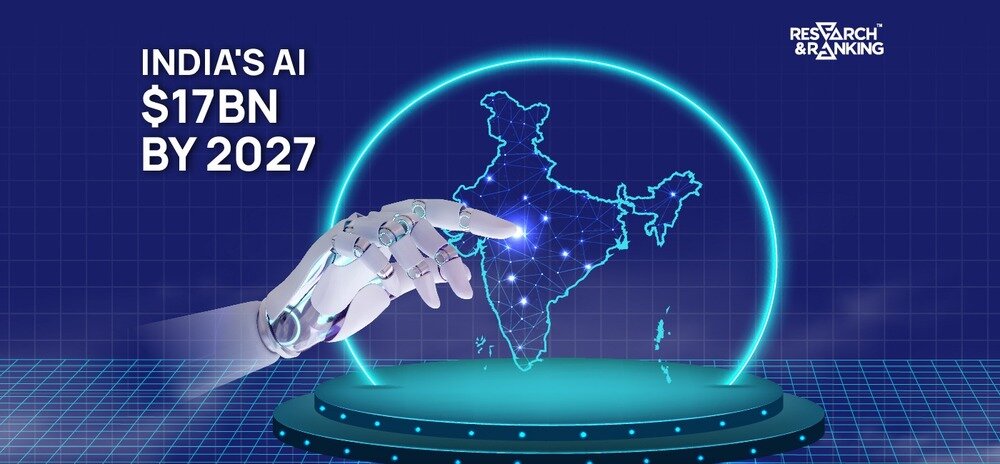India is emerging as a global leader in artificial intelligence (AI), with a projected market size of $17 billion by 2027. This growth will be driven by increasing enterprise tech spending, India’s growing AI talent base, and a significant increase in AI investments.

AI: The Top Category of IT Spending
According to a report by Nasscom-BCG, AI and machine learning (ML) will become the top category of IT spending by 2023, surpassing cloud computing, cybersecurity, and IoT. The report, “AI-Powered Tech Services: A Roadmap for Future Ready Firms; AI & GenAI’s Role in Turbocharging the Industry,” was launched at the Nasscom Technology & Leadership Forum 2024.
The report estimates that India’s AI market will grow at a compound annual growth rate (CAGR) of 25% till 2027, with similar growth in AI investments. Globally, investments in AI have seen a 24% CAGR since 2019, with 2023 seeing close to $83 billion invested. Most of this was made in horizontal AI applications across data analytics, genAI, and ML algorithms and platforms.
India: A hub of AI talent and innovation
India has a robust AI ecosystem, with the second-highest installed talent base of 420,000 employees working in AI roles. With the highest skills penetration, we have three times more AI-skilled talent than other countries. Plus, as a nation, we rank among the top five nations with a 14-time growth in individuals skilled in AI in the last seven years.
As the demand for AI talent in India is expected to grow at 25% CAGR till 2027, the technology industry in India has already seen over 15% growth in AI/ML jobs over the past 12 months, with positions such as AI engineers growing at 67% year-on-year.
Tech companies are expanding their portfolios beyond traditional IT and business process management to include AI-driven analytics, intelligent automation, and personalized customer interactions. These companies are not just adopting AI – they are redefining their service offerings, creating more value for their clients, and setting new industry standards.
AI’s Key Contributions to India’s Sustainable and Inclusive Future:
Transforming Key Sectors:
- Healthcare: Improved access to quality care and personalized treatments.
- Education: Enhanced learning outcomes and personalized learning experiences.
- Agriculture: Increased productivity and optimized resource use.
- Governance: Better public service delivery and efficient resource allocation.
Enabling Social and Economic Inclusion:
- New opportunities for employment, entrepreneurship, and innovation.
- Empowering marginalized groups with access to information, education, and financial services.
Promoting Environmental Sustainability:
- Reduced carbon emissions through optimized processes and energy management.
- Enhanced disaster management and resource utilization.
- Supporting India’s commitments under the Paris Agreement.
Creating Value and Impact on India’s Economy and Society
The report estimates that AI can add up to $957 billion to India’s GDP by 2035, equivalent to 15% of the current GDP. It can also create new jobs, enhance skills, and improve the quality of life for millions of Indians.
Some of the success stories and best practices of AI applications in India, such as Aravind Eye Care System, AgroStar, NITI Aayog, and MyGov, have been highlighted in the report. It also suggests vital actions and initiatives to help India realize its AI vision and aspirations, such as creating a national AI strategy, building a robust AI ecosystem, fostering AI innovation and entrepreneurship, and ensuring AI ethics and governance.
Conclusion
India isn’t just poised to become a global AI powerhouse; it’s already on the trajectory, with a $17 billion market projected by 2027. Its solid talent base, flourishing ecosystem, and strategic vision for AI-led development fuel this growth.
By harnessing AI, India can create a ripple effect of prosperity, inclusivity, and environmental consciousness for its citizens and the world. This journey won’t be without its challenges. Still, with a clear vision and responsible implementation, India can write a new chapter in its history powered by the transformative potential of AI.
*Disclaimer Note: The securities quoted, if any, are for illustration only and are not recommendatory. This article is for education purposes only and shall not be considered as recommendation or investment advice by Research & Ranking. We will not be liable for any losses that may occur. Investment in securities market are subject to market risks. Read all the related documents carefully before investing. Registration granted by SEBI, membership of BASL, and certification from NISM in no way guarantee the performance of the intermediary or provide any assurance of returns to investors.
FAQs
What is the projected market size of AI in India by 2027?
According to a report by Nasscom-BCG, India’s AI market is expected to reach $17 billion by 2027, growing at a CAGR of 25%.
How is India’s AI talent base compared to other countries?
India has the second-highest installed talent base of 420,000 employees working in AI roles, with the highest skills penetration. India also ranks among the top five nations with a 14-fold growth in individuals skilled with AI in the last seven years.
How can AI contribute to India’s sustainable and inclusive future?
AI can transform key sectors such as healthcare, education, agriculture, and governance, enabling social and economic inclusion, promoting environmental sustainability, and creating value and impact for India’s economy and society. AI can also add up to $957 billion to India’s GDP by 2035, equivalent to 15% of the current GDP.
How useful was this post?
Click on a star to rate it!
Average rating 3.4 / 5. Vote count: 5
No votes so far! Be the first to rate this post.
I’m Archana R. Chettiar, an experienced content creator with
an affinity for writing on personal finance and other financial content. I
love to write on equity investing, retirement, managing money, and more.
-
Archana Chettiarhttps://www.equentis.com/blog/author/archana/
-
Archana Chettiarhttps://www.equentis.com/blog/author/archana/
-
Archana Chettiarhttps://www.equentis.com/blog/author/archana/
-
Archana Chettiarhttps://www.equentis.com/blog/author/archana/

